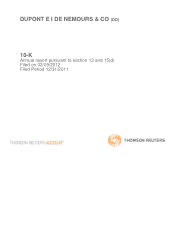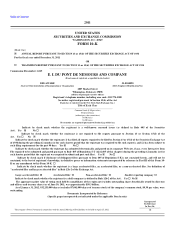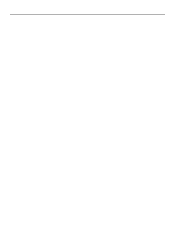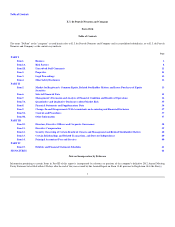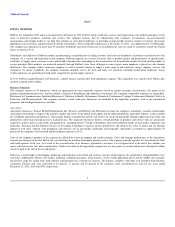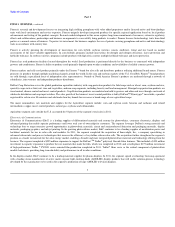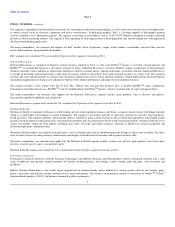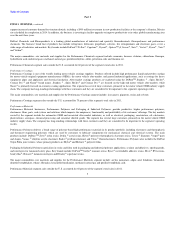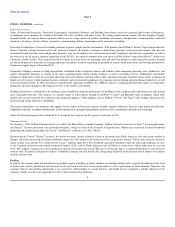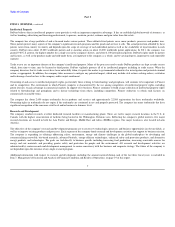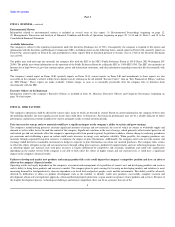DuPont 2011 Annual Report Download - page 9
Download and view the complete annual report
Please find page 9 of the 2011 DuPont annual report below. You can navigate through the pages in the report by either clicking on the pages listed below, or by using the keyword search tool below to find specific information within the annual report.
Table of Contents
Part I
ITEM 1. BUSINESS, continued
Safety & Protection
Safety & Protection businesses, Protection Technologies, Sustainable Solutions and Building Innovations, satisfy the growing global needs of businesses,
governments and consumers for solutions that make life safer, healthier and more secure. By uniting market-driven science with the strength of highly
regarded brands, the segment delivers products and services to a large number of markets, including construction, transportation, communications, industrial
chemicals, oil and gas, electric utilities, automotive, manufacturing, defense, homeland security and safety consulting.
Protection Technologies is focused on finding solutions to protect people and the environment. With products like DuPont™ Kevlar® high strength material,
Nomex® thermal resistant material and Tyvek® protective material, the business continues to hold strong positions in life protection markets and meet the
continued demand for body armor and personal protective gear for the military, law enforcement personnel, firefighters and other first responders, as well as
for workers in the oil and gas industry around the world. In 2011, the business announced the start up of its $500 million Cooper River Kevlar® facility near
Charleston, South Carolina. The Cooper River Kevlar® plant uses state-of-the-art technology that will allow the business to meet increased customer demand
for advanced protective materials in emerging industries around the world by expanding its portfolio of science-based innovations and boosting productivity.
Commercial supply began at the end of 2011.
Sustainable Solutions continues to help organizations worldwide reduce workplace injuries and fatalities while improving operating costs, productivity and
quality. Sustainable Solutions is a leader in the safety consulting field, selling training products, as well as consulting services. Additionally, Sustainable
Solutions is dedicated to clean air, clean fuel and clean water with offerings that help reduce sulfur and other emissions, formulate cleaner fuels, or dispose of
liquid waste. Its goal is to help maintain business continuity and environmental compliance for companies in the refining and petrochemical industries, as well
as for government entities. In 2010, the business completed the acquisition of MECS, Inc. (MECS), which is a leading global provider of process technology,
proprietary specialty equipment and technical services to the sulfuric acid industry.
Building Innovations is committed to the building science behind increasing the performance of building systems, helping reduce operating costs and creating
more sustainable structures. The business is a market leader of solid surfaces through its DuPont™ Corian® and Montelli® lines of products which offer
durable and versatile materials for residential and commercial purposes. Other products such as DuPont™ Tyvek® and Typar® offer leading solutions for the
protection and energy efficiency of buildings.
The major commodities, raw materials and supplies for the Safety & Protection segment include: alumina hydroxide, benzene, high density polyethylene,
isophthaloyl chloride, metaphenylenediamine, methyl methacrylate, paraphenylenediamine, polyester fiber, terephthaloyl chloride and wood pulp.
Safety & Protection segment sales outside the U.S. accounted for 63 percent of the segment's total sales in 2011.
Pharmaceuticals
On October 1, 2001, DuPont Pharmaceuticals was sold to the Bristol-Myers Squibb Company. DuPont retained its interest in Cozaar ® (losartan potassium)
and Hyzaar® (losartan potassium with hydrochlorothiazide), which are used in the treatment of hypertension. DuPont has exclusively licensed worldwide
marketing and manufacturing rights for Cozaar ® and Hyzaar® to Merck & Co., Inc. (Merck).
Pharmaceuticals' Cozaar® /Hyzaar® income is the sum of two parts: income related to a share of the profits from North American sales and certain markets in
Europe, and royalty income derived from worldwide contract net sales linked to the exclusivity term in a particular country. Patents and exclusivity started to
expire in prior years and the U.S. exclusivity for Cozaar® ended in April 2010. The worldwide agreement terminates when the following conditions are met:
(i) the Canadian exclusivity ends (which occurred in January 2012), and (ii) North American sales fall below a certain level, which could occur by year end
2012. The company experienced its first significant step-down in income from Cozaar®/Hyzaar® in 2010 and expects a continued step-down to zero when the
contract ends. In general, management expects a traditional earnings and cash decline for a drug going off patent in the pharmaceutical industry to continue
until the contract ends.
Backlog
In general, the company does not manufacture its products against a backlog of orders and does not consider backlog to be a significant indicator of the level
of future sales activity. Production and inventory levels are based on the level of incoming orders as well as projections of future demand. Therefore, the
company believes that backlog information is not material to understanding its overall business and should not be considered a reliable indicator of the
company's ability to achieve any particular level of revenue or financial performance.
6

